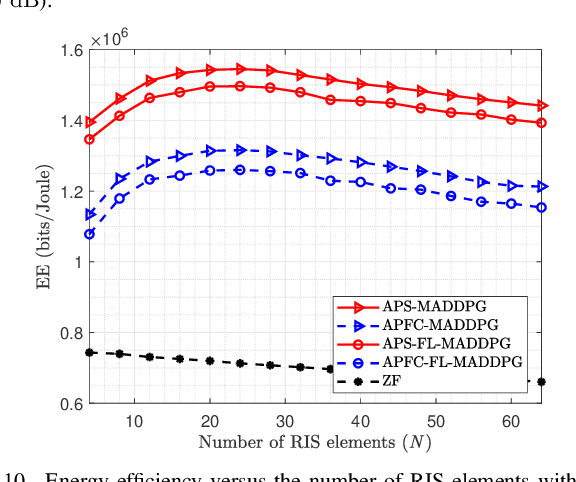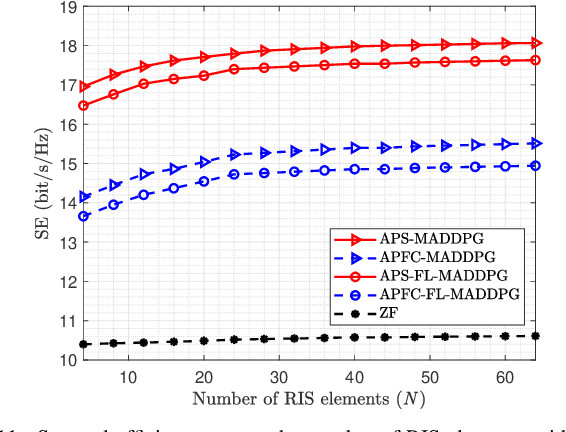Yiyang Zhu
Beamforming Design for Beyond Diagonal RIS-Aided Cell-Free Massive MIMO Systems
Mar 10, 2025Abstract:Reconfigurable intelligent surface (RIS)-aided cell-free (CF) massive multiple-input multiple-output (mMIMO) is a promising architecture for further improving spectral efficiency (SE) with low cost and power consumption. However, conventional RIS has inevitable limitations due to its capability of only reflecting signals. In contrast, beyond-diagonal RIS (BD-RIS), with its ability to both reflect and transmit signals, has gained great attention. This correspondence focuses on using BD-RIS to improve the sum SE of CF mMIMO systems. This requires completing the beamforming design under the transmit power constraints and unitary constraints of the BD-RIS, by optimizing active and passive beamformer simultaneously. To tackle this issue, we introduce an alternating optimization algorithm that decomposes it using fractional programming and solves the subproblems alternatively. Moreover, to address the challenge introduced by the unitary constraint on the beamforming matrix of the BD-RIS, a manifold optimization algorithm is proposed to solve the problem optimally. Simulation results show that BD-RISs outperform RISs comprehensively, especially in the case of the full connected architecture which achieves the best performance, enhancing the sum SE by around 40% compared to ideal RISs.
Joint Power Allocation and Phase Shift Design for Stacked Intelligent Metasurfaces-aided Cell-Free Massive MIMO Systems with MARL
Feb 27, 2025Abstract:Cell-free (CF) massive multiple-input multiple-output (mMIMO) systems offer high spectral efficiency (SE) through multiple distributed access points (APs). However, the large number of antennas increases power consumption. We propose incorporating stacked intelligent metasurfaces (SIM) into CF mMIMO systems as a cost-effective, energy-efficient solution. This paper focuses on optimizing the joint power allocation of APs and the phase shift of SIMs to maximize the sum SE. To address this complex problem, we introduce a fully distributed multi-agent reinforcement learning (MARL) algorithm. Our novel algorithm, the noisy value method with a recurrent policy in multi-agent policy optimization (NVR-MAPPO), enhances performance by encouraging diverse exploration under centralized training and decentralized execution. Simulations demonstrate that NVR-MAPPO significantly improves sum SE and robustness across various scenarios.
Mobile Cell-Free Massive MIMO with Multi-Agent Reinforcement Learning: A Scalable Framework
Dec 03, 2024



Abstract:Cell-free massive multiple-input multiple-output (mMIMO) offers significant advantages in mobility scenarios, mainly due to the elimination of cell boundaries and strong macro diversity. In this paper, we examine the downlink performance of cell-free mMIMO systems equipped with mobile-APs utilizing the concept of unmanned aerial vehicles, where mobility and power control are jointly considered to effectively enhance coverage and suppress interference. However, the high computational complexity, poor collaboration, limited scalability, and uneven reward distribution of conventional optimization schemes lead to serious performance degradation and instability. These factors complicate the provision of consistent and high-quality service across all user equipments in downlink cell-free mMIMO systems. Consequently, we propose a novel scalable framework enhanced by multi-agent reinforcement learning (MARL) to tackle these challenges. The established framework incorporates a graph neural network (GNN)-aided communication mechanism to facilitate effective collaboration among agents, a permutation architecture to improve scalability, and a directional decoupling architecture to accurately distinguish contributions. In the numerical results, we present comparisons of different optimization schemes and network architectures, which reveal that the proposed scheme can effectively enhance system performance compared to conventional schemes due to the adoption of advanced technologies. In particular, appropriately compressing the observation space of agents is beneficial for achieving a better balance between performance and convergence.
Joint Precoding and AP Selection for Energy Efficient RIS-aided Cell-Free Massive MIMO Using Multi-agent Reinforcement Learning
Nov 17, 2024



Abstract:Cell-free (CF) massive multiple-input multiple-output (mMIMO) and reconfigurable intelligent surface (RIS) are two advanced transceiver technologies for realizing future sixth-generation (6G) networks. In this paper, we investigate the joint precoding and access point (AP) selection for energy efficient RIS-aided CF mMIMO system. To address the associated computational complexity and communication power consumption, we advocate for user-centric dynamic networks in which each user is served by a subset of APs rather than by all of them. Based on the user-centric network, we formulate a joint precoding and AP selection problem to maximize the energy efficiency (EE) of the considered system. To solve this complex nonconvex problem, we propose an innovative double-layer multi-agent reinforcement learning (MARL)-based scheme. Moreover, we propose an adaptive power threshold-based AP selection scheme to further enhance the EE of the considered system. To reduce the computational complexity of the RIS-aided CF mMIMO system, we introduce a fuzzy logic (FL) strategy into the MARL scheme to accelerate convergence. The simulation results show that the proposed FL-based MARL cooperative architecture effectively improves EE performance, offering a 85\% enhancement over the zero-forcing (ZF) method, and achieves faster convergence speed compared with MARL. It is important to note that increasing the transmission power of the APs or the number of RIS elements can effectively enhance the spectral efficiency (SE) performance, which also leads to an increase in power consumption, resulting in a non-trivial trade-off between the quality of service and EE performance.
Cooperative Multi-Target Positioning for Cell-Free Massive MIMO with Multi-Agent Reinforcement Learning
Oct 09, 2024



Abstract:Cell-free massive multiple-input multiple-output (mMIMO) is a promising technology to empower next-generation mobile communication networks. In this paper, to address the computational complexity associated with conventional fingerprint positioning, we consider a novel cooperative positioning architecture that involves certain relevant access points (APs) to establish positioning similarity coefficients. Then, we propose an innovative joint positioning and correction framework employing multi-agent reinforcement learning (MARL) to tackle the challenges of high-dimensional sophisticated signal processing, which mainly leverages on the received signal strength information for preliminary positioning, supplemented by the angle of arrival information to refine the initial position estimation. Moreover, to mitigate the bias effects originating from remote APs, we design a cooperative weighted K-nearest neighbor (Co-WKNN)-based estimation scheme to select APs with a high correlation to participate in user positioning. In the numerical results, we present comparisons of various user positioning schemes, which reveal that the proposed MARL-based positioning scheme with Co-WKNN can effectively improve positioning performance. It is important to note that the cooperative positioning architecture is a critical element in striking a balance between positioning performance and computational complexity.
Distributed Collaborative User Positioning for Cell-Free Massive MIMO with Multi-Agent Reinforcement Learning
Oct 07, 2024



Abstract:In this paper, we investigate a cell-free massive multiple-input multiple-output system, which exhibits great potential in enhancing the capabilities of next-generation mobile communication networks. We first study the distributed positioning problem to lay the groundwork for solving resource allocation and interference management issues. Instead of relying on computationally and spatially complex fingerprint positioning methods, we propose a novel two-stage distributed collaborative positioning architecture with multi-agent reinforcement learning (MARL) network, consisting of a received signal strength-based preliminary positioning network and an angle of arrival-based auxiliary correction network. Our experimental results demonstrate that the two-stage distributed collaborative user positioning architecture can outperform conventional fingerprint positioning methods in terms of positioning accuracy.
 Add to Chrome
Add to Chrome Add to Firefox
Add to Firefox Add to Edge
Add to Edge